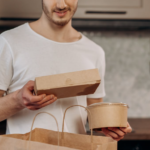At a time when the echoes of environmental sustainability grow louder with each passing day, the shift towards greener practices has become imperative for businesses and consumers alike.
Among the myriad of sustainability topics, packaging with biodegradable solutions stands out as a crucial step in mitigating the impacts of waste on our planet.
This journey is not just about choosing eco-friendly materials; it’s about reimagining the lifecycle of our products from production to post-consumption.
Reviewing Biodegradable Packaging
At its core, biodegradable packaging is designed to return to nature, breaking down and decomposing into natural elements within a short time after disposal. This concept is a beacon of hope in the fight against the ever-growing mountains of waste, particularly plastic, that pollute our oceans and landscapes. Biodegradable materials, such as plant-based plastics, recycled paper, and organic fabrics, offer an eco-conscious alternative that supports the natural cycle of decomposition.
Advantages of Going Biodegradable
The transition to biodegradable packaging carries with it a multitude of benefits. Firstly, it significantly reduces the volume of waste that ends up in landfills and water bodies. Secondly, it conserves resources by using materials that are renewable and often sourced from waste products themselves. Moreover, this shift fosters a more sustainable brand image, appealing to a growing demographic of environmentally conscious consumers.
Challenges on the Path
Despite its advantages, the adoption of biodegradable packaging is not without its hurdles. Issues such as cost implications, the complexity of supply chains, and regulatory standards pose challenges for businesses eager to make the switch. Additionally, there is a pressing need for widespread consumer education on proper disposal methods to ensure that biodegradable materials are composted correctly, thus fulfilling their eco-friendly potential.
Choosing the Right Biodegradable Packaging Solution for Your Needs
Selecting appropriate compostable packaging materials requires careful consideration of several factors. It includes the type of product in question, storage and transportation conditions, and the target market’s environmental awareness. It’s essential to partner with suppliers who not only provide a range of options but also understand the nuances of biodegradable materials and their impact on the environment.
The Future is Biodegradable
The movement towards biodegradable packaging is more than a trend; it’s part of a broader, global shift towards sustainability. Innovations in material science and technology are paving the way for more efficient and affordable biodegradable solutions. As we continue to witness advancements in this field, the dream of a waste-free world becomes increasingly tangible.
In Closing: Embracing the Change
Embracing biodegradable packaging is an essential step in the journey towards environmental sustainability. It represents a commitment to the health of our planet and the well-being of future generations.
By making informed choices and advocating for greener alternatives, businesses and consumers can drive significant positive change. The path may be fraught with challenges, but the rewards— a cleaner, greener earth— are undoubtedly worth it.
For those interested in delving deeper into the impacts of packaging on the environment, the global waste crisis is a topic rich with insights and information. Understanding the magnitude of this issue can further underscore the importance of transitioning to biodegradable packaging solutions and the role they play in mitigating environmental degradation.



